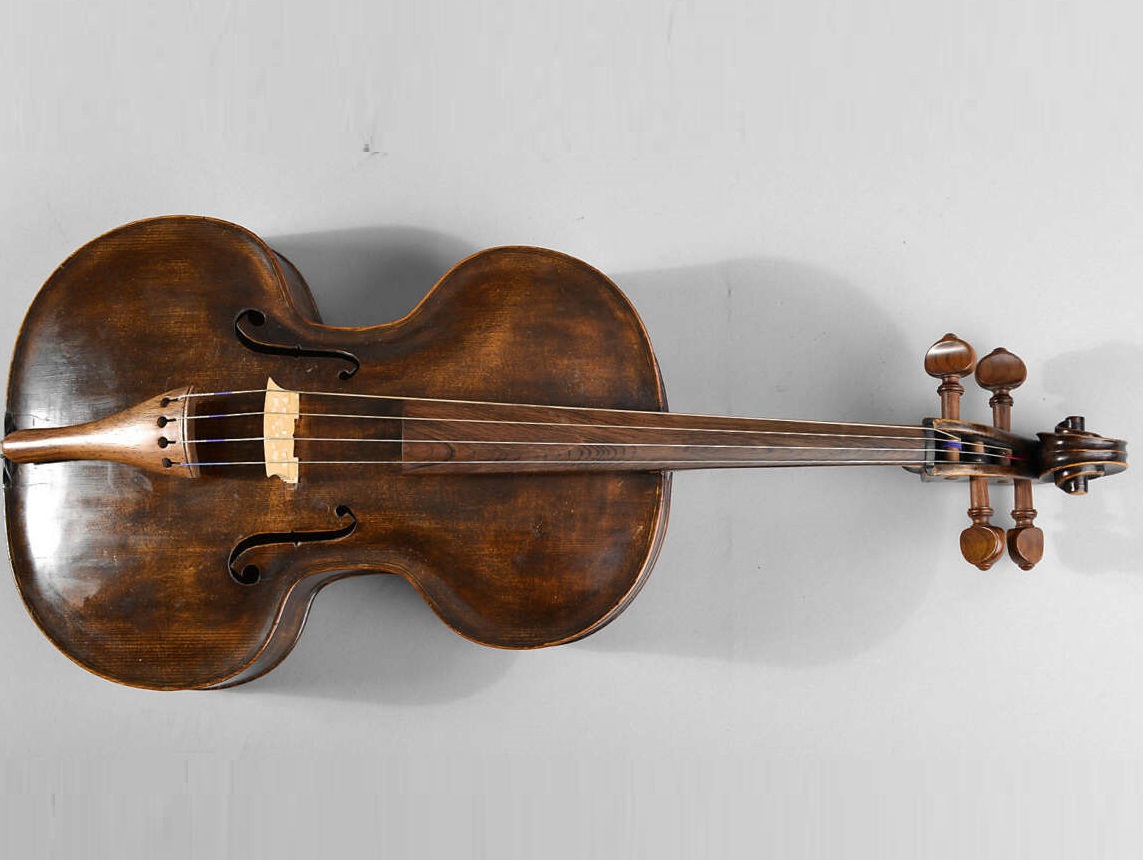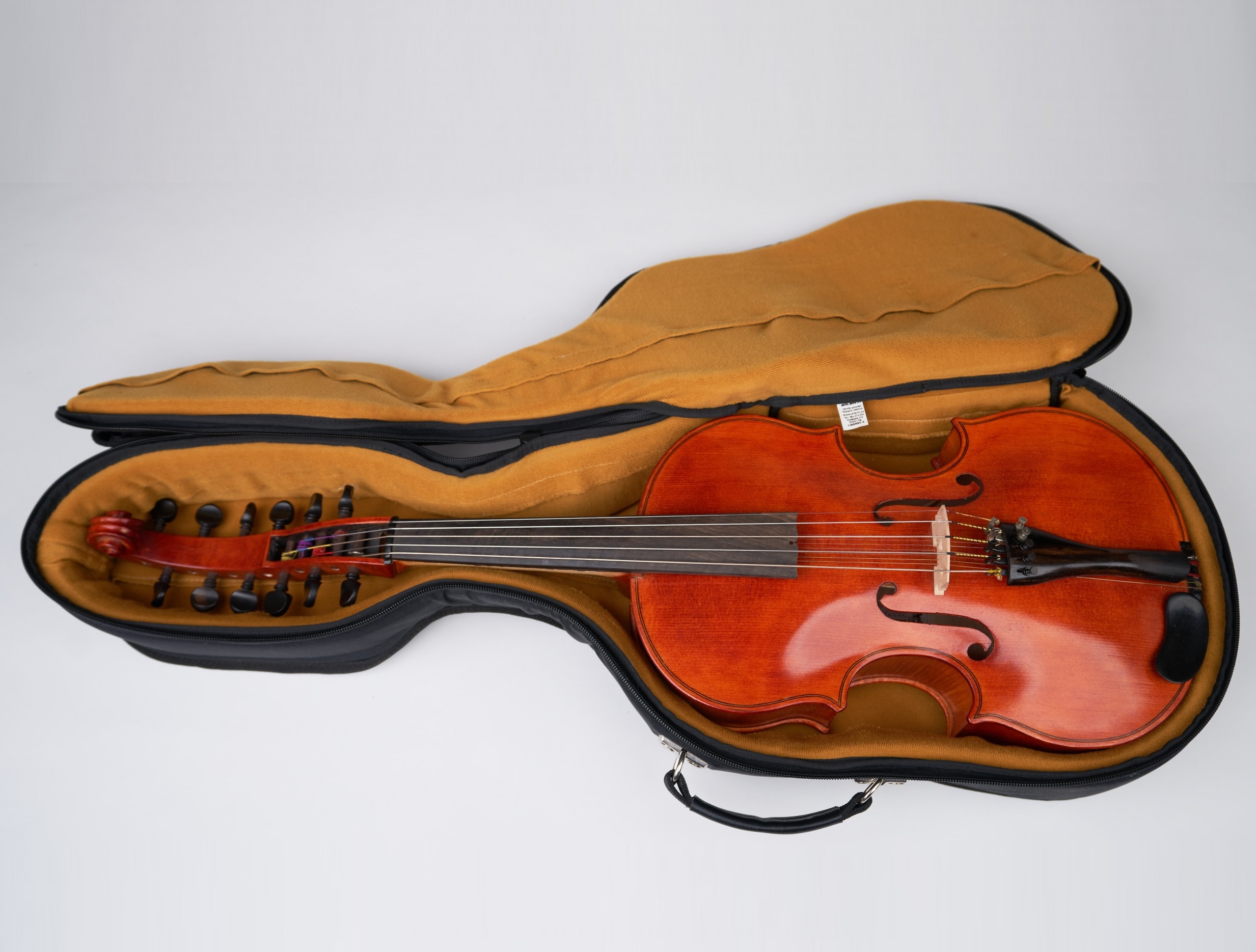Viola pomposa
Bowed Instruments
Europe
Between 1001 and 1900 AD
Video
The viola pomposa is a stringed musical instrument that serves as a hybrid between the violin family and the viol family. It features five strings, which allows it to cover a broader range than the traditional viola. The instrument is slightly larger than a standard viola but remains smaller than a cello, making it an interesting fusion in terms of size, tone, and versatility. The term “pomposa” means “pompous” or “grand,” reflecting its rich and resonant sound quality. The viola pomposa is played with a bow, much like the violin or viola, but it has a unique tuning that allows it to reach lower pitches while retaining a bright upper register.
Type of Instrument
The viola pomposa belongs to the category of bowed string instruments. It is closely related to both the viola and the cello in terms of its tonal range and playing technique. This instrument can be classified as a chordophone because it produces sound through the vibration of its strings. As a five-stringed instrument, it extends the capabilities of the traditional viola, bridging the gap between the two instrument families. It is often used in solo performances, chamber music, and orchestral settings where its distinctive tonal range can be fully appreciated.
Historical Bckground
Origins and Development
The viola pomposa originated in Europe during the 18th century, primarily in Germany and Italy. The viola pomposa emerged during the Baroque period (1600–1750), a time when instrument makers were experimenting with different designs to accommodate evolving musical styles. The instrument is often attributed to Johann Sebastian Bach, who is believed to have played a role in its development. Some sources suggest that Bach designed the instrument for himself and other musicians who desired greater melodic flexibility and extended range.
The name “pomposa”, meaning “pompous” or “grand” in Italian, reflects the instrument’s rich sound and prominent role in early music compositions. The viola pomposa was used both as a solo instrument and in ensemble settings, often fulfilling roles similar to those of the viola and cello.
Decline in Popularity
Despite its initial success, the viola pomposa gradually faded from common use. The standard four-string viola and cello became more established, and orchestras began to favor these instruments due to their standardized tuning and technique. Additionally, changing musical styles in the Classical period (1750–1820) led to a decline in the demand for hybrid instruments like the viola pomposa.
Materials and Construction
The viola pomposa is made from traditional tonewoods, similar to those used in the violin family. The top is typically made from spruce, which enhances the resonance and clarity of the sound. The back, sides, and neck are commonly made from maple, which provides strength and durability. The fingerboard, tailpiece, and tuning pegs are often crafted from ebony, ensuring smooth playability and fine adjustments.
The five strings of the viola pomposa are usually made from gut, synthetic materials, or metal, depending on the desired tonal characteristics. The bridge and soundpost are carefully positioned to optimize sound production, allowing for a rich, projecting tone. The bow used to play the viola pomposa is similar to that of the violin or viola, but some players prefer a slightly heavier bow to accommodate the instrument’s broader range.
Types of Viola Pomposa
While there are not many widely recognized subtypes of the viola pomposa, variations exist based on tuning, size, and playing styles. Some versions of the viola pomposa are more closely aligned with the cello and are played da spalla (on the shoulder), while others are played under the chin like a viola. Some makers have experimented with different tunings and string materials to enhance the instrument’s versatility. Modern adaptations of the viola pomposa have been made to suit contemporary performance practices, sometimes incorporating carbon fiber or other advanced materials.
Characteristics
The viola pomposa has several distinguishing characteristics that set it apart from other string instruments. One of its defining features is the additional fifth string, which extends the instrument’s range. Traditional violas have four strings tuned in perfect fifths (C-G-D-A), whereas the viola pomposa adds a high E string, mirroring the tuning of the violin while retaining the lower range of the viola.
The instrument has a rich, warm, and resonant tone, often described as a blend between the viola and cello. It has a slightly deeper body than a standard viola, which contributes to its fuller sound. The five-string setup allows for more complex chordal possibilities and makes the instrument particularly suited for solo and chamber music performances.
Sound Production
Sound is produced on the viola pomposa through the vibration of the strings when bowed or plucked. The bow, when drawn across the strings, causes them to oscillate, creating sound waves that resonate within the hollow body of the instrument. The bridge transfers these vibrations to the soundboard, amplifying the sound and giving it its characteristic warmth and depth.
Players can control dynamics and tone color by adjusting bow pressure, speed, and contact point. The additional high string allows musicians to reach higher notes with ease, making the viola pomposa an expressive instrument with a broad dynamic range.
Playing Methods
The viola pomposa can be played in multiple ways, depending on the performer’s preference and the musical context. Some musicians hold it under the chin like a viola, while others play it da spalla, resting the instrument on their shoulder or chest, similar to a small cello. This versatility allows performers to explore different playing techniques and repertoires.
The instrument is played with a bow, using techniques such as legato, staccato, spiccato, and pizzicato. Due to its extended range, it requires advanced fingering techniques to navigate between the strings efficiently. Musicians must be adept at shifting positions and controlling bowing techniques to maximize the instrument’s expressive potential.
Roles in Music
The viola pomposa was historically used in Baroque compositions, especially in works that required an extended range. Some of Bach’s compositions, including certain solo and ensemble pieces, are believed to have been written with this instrument in mind. The instrument was particularly useful for playing both bass and melody lines, making it ideal for chamber music and orchestral arrangements.
In modern times, the viola pomposa is occasionally used in period performances of Baroque music, as well as in contemporary compositions that explore its unique tonal capabilities. Some jazz and experimental musicians have also embraced the instrument for its versatility and extended range.
Cultural Significance
The viola pomposa holds an important place in the history of stringed instruments, representing an era of musical experimentation and innovation. Though it did not achieve widespread popularity, it influenced the development of later string instruments and contributed to the evolution of Baroque music. Today, it is mostly found in early music ensembles, museums, and among musicians dedicated to historical performance practices.
The instrument’s ability to blend viola and cello qualities makes it a valuable tool for composers and performers seeking a distinctive sound. Its revival in certain musical circles demonstrates an ongoing appreciation for historical instruments and their unique contributions to music.
Overall, the viola pomposa remains a fascinating and historically significant instrument that continues to inspire musicians and instrument makers alike. Whether used for Baroque music or innovative modern compositions, it serves as a bridge between different eras and musical traditions.
FAQ
How is the Viola Pomposa constructed?
The Viola Pomposa is built similarly to a viola but has five strings instead of four. It features a slightly wider body to accommodate the extra string and enhanced resonance. The fingerboard and bridge are adjusted to support the additional string. Its design allows for a richer tonal range.
What materials are used to make the Viola Pomposa?
Traditionally, the Viola Pomposa is crafted from spruce for the top and maple for the back, sides, and neck. Ebony is used for the fingerboard, pegs, and tailpiece. The strings are typically made of gut or synthetic core materials, sometimes wound with metal for durability.
How does the Viola Pomposa sound?
The Viola Pomposa has a rich, warm tone with extended range due to its extra string. It blends the deep, resonant qualities of the viola with the brightness of the violin. The additional high E string enables a broader melodic capability, making it suitable for both solo and ensemble performances.
 Links
Links
References
Other Instrument
Categories



















